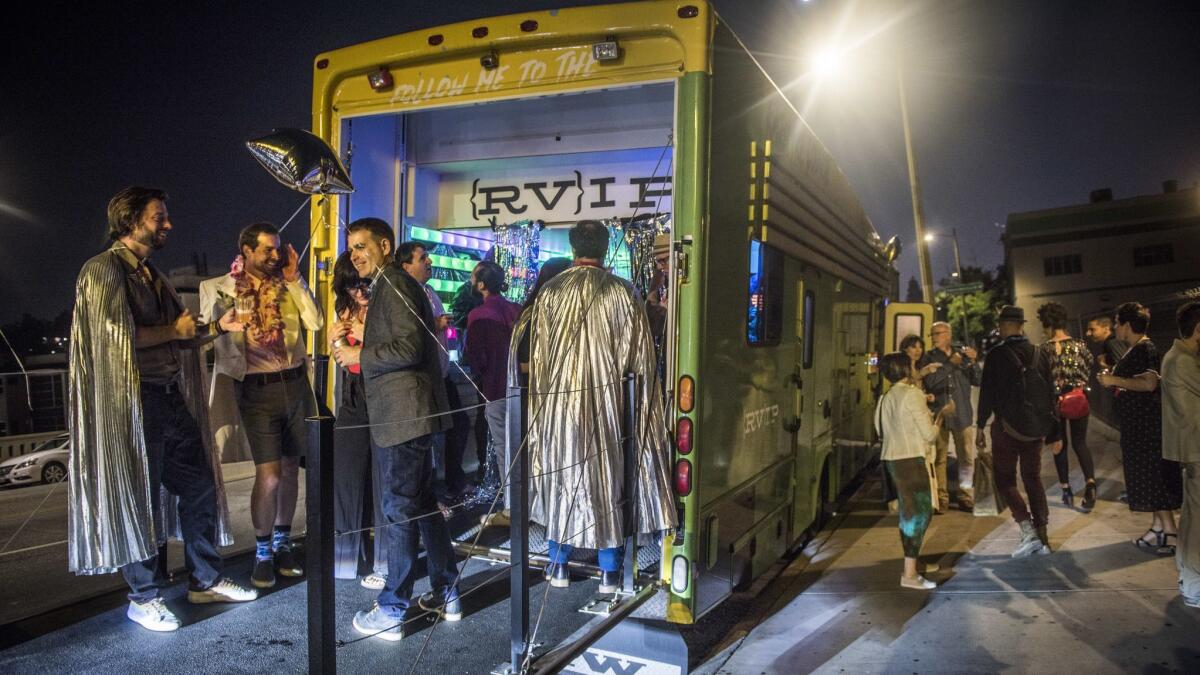Paying tribute to a Disney Imagineering legend on the rollicking karaoke RV he loved
- Share via
They sang Scott Watson to the stars until the wee hours of the night along Sunset Boulevard, aboard the roving karaoke RV that he helped transform into an oasis on wheels for creative souls.
Watson, who died Aug. 12 when the single-engine plane he was piloting crashed in Sylmar, was well-known on the RVIP, a state-of-the-art mobile karaoke bar based in Los Angeles and a popular fixture at SXSW and other tech-meets-art festivals.
He served as its chief technology officer — that is, when he wasn’t working his dedicated day job as CTO and senior vice president at Walt Disney Imagineering. The accident, currently under federal investigation, cut short a life filled with remarkable behind-the-scenes innovations that reached millions during his 30-year career at Disney.
On Saturday, family, friends and Disney colleagues past and present gathered in Los Angeles, first at Disney Imagineering in Glendale and then outside the El Cid restaurant in Silver Lake to remember Watson and his contributions to the many artist communities he championed, paying tribute all night long with beloved “Scott songs” and toasts to the late innovator and engineer.
“[Morrissey’s] ‘Suedehead’ was probably his No. 1 favorite song, and it’s the song that’s been running through my head,” said RVIP cofounder Jonathan Grubb of Watson, whom he first met at a dinner party years ago.
When Grubb and partner Kestrin Pantera took the fledgling project on its maiden voyage to SXSW, Watson stayed until sunrise and became part of the family; when they later made a business out of it, he officially signed on as CTO, creating an onboard talking “karaoke robot” and song-picking applications still in use today.
Watson, a prolific inventor who held dozens of patents, also designed the programmable external LED light display that welcomes visitors like a beacon to the RV, an extension of his longstanding interest in tinkering with lights and lasers.
“While he loved a good party, he was equally happy spending a full day debugging software on his laptop,” his daughter Katie Watson said via email, remembering a father who made grilled cheese sandwiches with a blowtorch, loved to snowboard, longboard and paraglide and never flagged in his patience and passion for science.
Friends dubbed him the “Wizard of Awes,” the kind of genius whose achievements behind the curtain often go unsung.
Leading technological explorations at Disney Imagineering Research and Development, the creative engineering arm of Disney, Watson helped create iconic theme park attractions, including the cutting-edge Aladdin VR experience that predated the current wave of immersive virtual reality storytelling and Soarin’ Over California, which became Soarin’ over the World.
Jon Snoddy, a senior vice president at Disney Imagineering, knew Watson for 30 years and worked closely with him, once spending three months experimenting with “junkyard parts” for a new project, the scrappy prototype that would become the iconic Indiana Jones ride.
Watson was often ahead of his time, said Snoddy, spearheading technology that would later become popular; it’s thanks to Watson that the Mouse House was an early adapter of the internet.
“Scott registered the domain on his company credit card, Disney.com. Nobody even knew what that was, it was so early!” said Snoddy, who remembers Watson programming the first-ever page on the company’s website — “a yellow page with Mickey Mouse in the middle of it” — on a computer that sat beside Watson’s desk for years. “It is crazy, but somebody from every company has to be that person.”
He described a fearless innovator unafraid of technical problems to which solutions didn’t yet exist. “He would go around like a little bee, pollinating projects, and they would always come out better,” Snoddy said. “He was the same Scott that [other friends] know, just as loose, spontaneous, full of energy and creative. And creativity is water — it’s what we run on.”
Watson found kindred spirits in the Southern California arts scene and at Burning Man, where he served as a “green dot” community ranger helping individuals suffering extreme emotional experiences during the festival.
At Saturday’s memorial and in interviews, friends, family and colleagues describe a tenacity and kindness of spirit that rubbed off on everyone he knew. Some, like Mark Trammell and Portia Wells, traveled from out of state to attend the memorial, remembering how Watson had helped orchestrate their own engagement on the RVIP.
“A common refrain, even in a moment as hard as this one, is ‘We’ll figure it out,’ ” wrote son Shane Watson via email. “And we do. And he did. He dreamed wildly and pursued those dreams with everything he had. And why not? He would figure it out.”
Watson is survived by daughters Elizabeth and Katie, son Shane, grandson Pascal and fiancée Maraya Cornell, who lived with Watson in Los Feliz and Marina del Rey.
Plans are being formulated to send his ashes to the moon via SpaceX-adjacent services — or rather, “back to the moon,” as Shane Watson says, because “anyone with such a clear-eyed vision of the future must be from the future.”
“I really fell in love with him because he was kind, caring and faithful,” said Cornell, a day after friends celebrated his memory until 3 a.m. with songs, shiny capes, and champagne. It was a spirited tribute he would have appreciated, she said. “He was larger than life. He would talk about going to the moon. He wasn’t afraid of big things, crazy things — things most people think are impossible.”

More to Read
Only good movies
Get the Indie Focus newsletter, Mark Olsen's weekly guide to the world of cinema.
You may occasionally receive promotional content from the Los Angeles Times.








